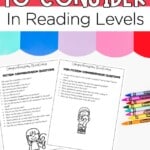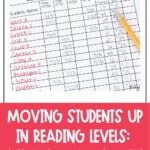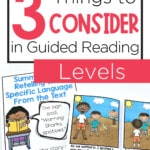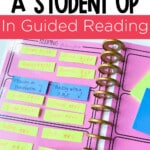


I remember in my early years of teaching, sitting at my kidney table after school and looking at my guided reading level tracker. Was it time to move up Susie? How did I know if it was time to move students up in guided reading levels? What did a student do in their reading that showed they were ready for the next level?
I sought out the help of my literacy coach, talked with my teaching team, and attended training sessions on guided reading levels and best practices. Over time, and with the knowledge and expertise of so many, I’ve learned what things to look for to be able to tell when a student is ready to move up a guided reading level.
When determining if a student is ready to move up in their guided reading level, there are certain things we will want to look at on our running records and anecdotal notes:
We don’t want to make the mistake of moving students up a level in guided reading when they aren’t ready. Let’s chat about each of these areas so you’ll know exactly when to consider changing guided reading levels for your students.
Reading accurately is crucial to comprehension of text. We want students to be able to read with a high level of accuracy when reading. Readers should use all of the decoding and reading strategies we have taught them throughout the year to help them read accurately.
They should be able to solve words efficiently and monitor and correct their reading at the level they are currently in. We don’t want to move a student up to a harder level who isn’t reading accurately and self-correcting. They will continue to struggle with accuracy while reading a harder text. We want to make sure students can read at a high level of accuracy with comprehension before we move them up.
To determine accuracy, look for students to be reading at 95% accuracy in levels A-J. In levels K-M, we want that rate to be at 98%. You will be able to know a student’s accuracy with reading by looking at a running record.
There are a few things to keep in mind when looking at a running record:
These are things that will help you know if a student is reading text accurately.
Fluency is when a student reads text accurately, smoothly, and with expression. We want them to read smoothly and with expression to help aid their comprehension. Fluent readers read text with appropriate phrasing and use intonation to make their voice sound like the character.
If a student is reading and sounds like a robot or reading too fast, we don’t want to just move them up in their level and work on fluency in the next level. Here is how I taught my students to self-monitor their fluency while reading:
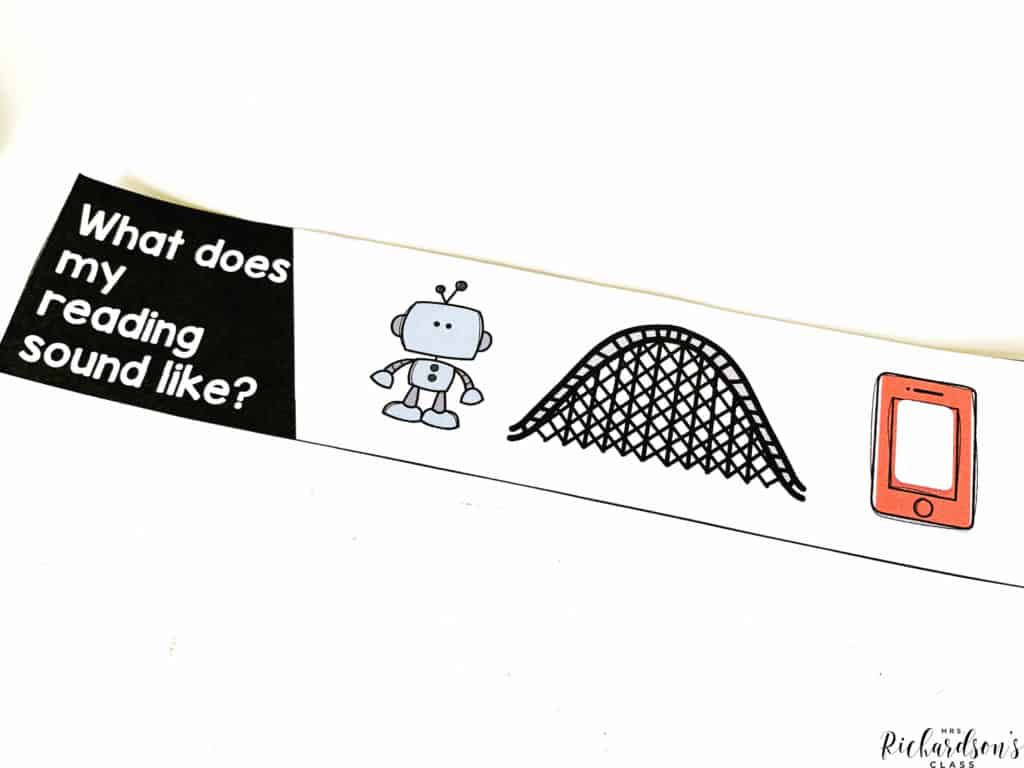
It’s best to work on their reading fluency in the level they are in and give them confidence. Have them repeatedly read books and phrases to help them build their fluency. You can find a few ways to practice fluency HERE. You will know they’re ready to move up when they are able to read text smoothly, with expression, and sound like they are talking on the phone.
Students should have strong comprehension skills before we move them up a level. Students should have developed different reading skills in that level, not just be able to identify the characters and problem. We want them to be able to tell us about the text (retell the story, identify the beginning, middle, and end), as well as make connections, make inferences, predictions, and visualize.
We want their comprehension of the text read to be deep and for them to be able to tell details and provide evidence. You can read more about how to check for comprehension HERE.
Grab your FREE list of comprehension questions for fiction and non-fiction text in the Reading Assessment Toolkit!
Students need to grow and expand these skills as they encounter more challenging texts. We don’t want to just move them up to the next level with surface-level comprehension skills. We want to make sure that they can deeply understand the books they are reading. You can learn how to support readers who struggle with comprehension HERE.
It is so important that students are able to read text accurately, with fluency and comprehension in a certain level over a week or two. We also want students to be able to read with these three things in many different texts.
Can they do it in nonfiction and fiction? Pull out your running records from the past few weeks. You will want to have a couple running records to look at for a specific student or conferring notes.
Are they consistently reading accurately? Not just on one running record. Over the past couple weeks, are they reading at a high level of accuracy in a couple different books?
Can they read with expression and fluency? Or do they sound like a robot? If they are really struggling with reading fluently, work with them in small group on this for a few weeks before you move them up.
Are they comprehending what they are reading? Can they retell the story? Can they make connections to what they are reading? Are they able to make connections and inferences in the text?
Spend some time looking over your running records and anecdotal notes you’ve been taking. Are students consistently reading accurately with fluency and expression and comprehending the story? If so, then they might be ready to move up a level.
Remember that the ultimate goal of reading isn’t just to move up levels, but to nurture a love of reading for both enjoyment and to learn new things.
Needing more help with guided reading levels and groups? Hop on my waitlist for Rethinking Guided Reading. This masterclass coaches you from the very start of guided reading with pre-assessments to how to set up groups and how to implement solid, effective lesson plans.
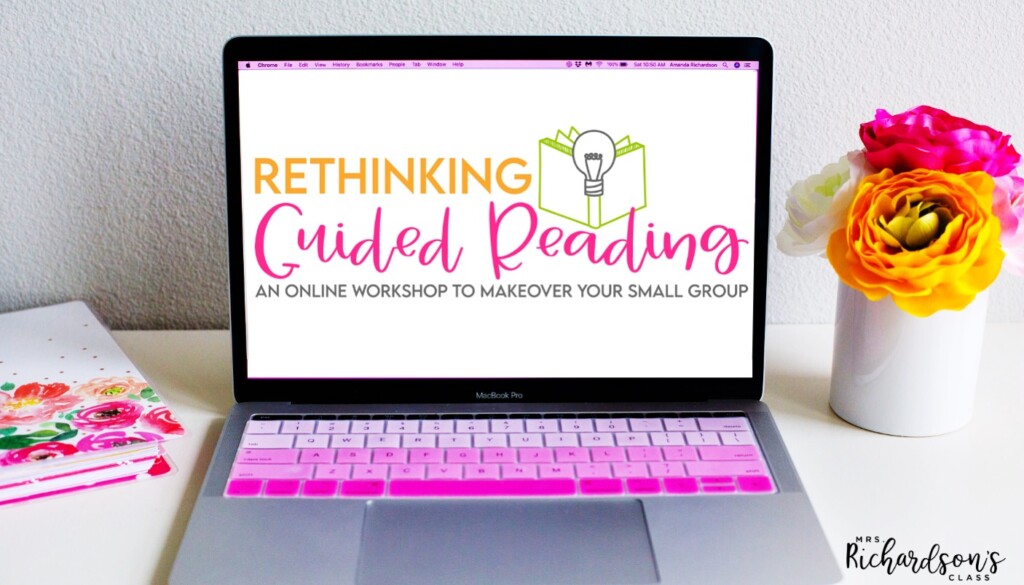
Get on the waitlist so you’re the first to know when the doors for registration opens. I only do this a few times a year, so you won’t want to miss out!

Want to use the latest research to boost your readers during small groups? This FREE guide is packed with engaging ideas to help them grow!

I’m a K-1 teacher who is passionate about making lessons your students love and that are easy to implement for teachers. Helping teachers like you navigate their way through their literacy block brings me great joy. I am a lifelong learner who loves staying on top of current literacy learning and practices. Here, you’ll find the tools you need to move your K-2 students forward!


| Cookie | Duration | Description |
|---|---|---|
| cookielawinfo-checkbox-analytics | 11 months | This cookie is set by GDPR Cookie Consent plugin. The cookie is used to store the user consent for the cookies in the category "Analytics". |
| cookielawinfo-checkbox-functional | 11 months | The cookie is set by GDPR cookie consent to record the user consent for the cookies in the category "Functional". |
| cookielawinfo-checkbox-necessary | 11 months | This cookie is set by GDPR Cookie Consent plugin. The cookies is used to store the user consent for the cookies in the category "Necessary". |
| cookielawinfo-checkbox-others | 11 months | This cookie is set by GDPR Cookie Consent plugin. The cookie is used to store the user consent for the cookies in the category "Other. |
| cookielawinfo-checkbox-performance | 11 months | This cookie is set by GDPR Cookie Consent plugin. The cookie is used to store the user consent for the cookies in the category "Performance". |
| viewed_cookie_policy | 11 months | The cookie is set by the GDPR Cookie Consent plugin and is used to store whether or not user has consented to the use of cookies. It does not store any personal data. |
